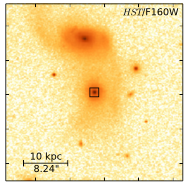
Credit: Comerford et al. 2017

Credit: Comerford et al. 2017
Supermassive Black Holes (SMBHs) exist in most if not all galaxies. If enough matter is accreted onto a SMBH then it becomes active and the galaxy is called Active Galactic Nuclei (AGN). Our Milky Way hosts a SMBH that was active <10 million years ago. Astronomers now detected an AGN, located 800 million light years away from Earth that presents evidence of turning off and on again.
Observations from different telescopes and at different wavelengths, i.e. optical, X-ray and near-Infrared (SDSS, Chandra, Hubble Space Telescope, APO/DIS, Keck) revealed two main structures in the galaxy: An extended ionized gas to the south (see top Figure) and a Northern bubble (see inset in top Figure). Their analysis showed that both of the structures are gas outflows driven by an AGN. Further analysis, indicated that these outflows didn’t occur simultaneously. The southern outflow is the results of an older AGN outburst while the northern outflow is the more recent AGN outburst. Therefore, the galaxy hosts an AGN that has recently turned on and then on again!
These outbursts could have been triggered by a galaxy merger. Indeed the team of astronomers detected a nearby galaxy that is still interacting with the studied object (bottom Figure). This interaction could have triggered nuclear inflows of gas in the studied galaxy, which produced the two episodes of accretion onto the SMBH that led to the two AGN outbursts.
More observations of similar objects will certainly uncover AGN outbursts and some of them may have evidence of past AGN activity as well.
Publication: Comerford et al. 2017
